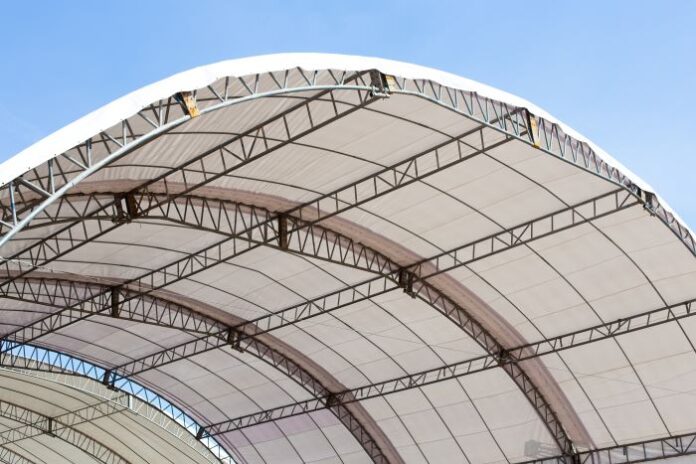Engineered fabric structures have emerged as a versatile and efficient solution for a wide range of applications. These innovative structures, characterized by their unique design and construction, offer numerous advantages over traditional building methods.
From rapid deployment and cost-effectiveness to sustainability and aesthetic appeal, fabric structures have redefined the possibilities of modern architecture. This article will discuss in detail the remarkable benefits these structures offer.
1. Cost-Effectiveness
Engineered fabric building offers significant cost advantages compared to traditional construction methods. One of the primary factors contributing to their cost-effectiveness is the lower material costs. The fabrics used in these structures, such as PVC-coated polyester or polyethylene, are generally less expensive than traditional building materials like steel or concrete.
The lightweight nature of these materials reduces transportation and handling costs. Additionally, the speed of construction associated with fabric structures directly translates into lower labor expenses. Since these structures can be assembled much faster than conventional buildings, the overall project timeline is shortened, resulting in reduced labor costs and fewer disruptions to ongoing operations.
2. Quick Installation
The rapid installation process of engineered fabric structures is one of their most compelling benefits. Unlike traditional buildings that may take months or years to complete, fabric structures can be erected in weeks. This speed is particularly advantageous in situations where time is of the essence, such as in emergency relief scenarios or when a temporary solution is needed for events or storage.
The components of these structures are often prefabricated, meaning they arrive on-site ready for assembly, which minimizes construction delays. Additionally, fabric structures typically require minimal site preparation. Since they are lighter than conventional buildings, they often don’t need deep foundations, which reduces the time and cost associated with site work.
3. Versatility and Flexibility
Engineered fabric buildings are highly versatile and adaptable to a wide range of applications. One key advantage is their customizable design. These structures can be tailored in terms of shape, size, and color to meet specific requirements, whether for industrial, agricultural, recreational, or commercial use.
Furthermore, the flexibility in design also extends to the structure’s lifespan; they can be engineered as temporary installations that are easily dismantled and relocated. This adaptability makes them suitable for industries where needs might change over time, such as in construction projects, where temporary shelters or storage facilities are often required.
4. Durability and Strength
Despite their lightweight appearance, engineered fabric structures are remarkably durable and strong. The materials used, such as PVC-coated polyester or PTFE, are designed to withstand harsh environmental conditions. This fabric material have high tensile strength, meaning they can endure significant stress without tearing or stretching. This makes them suitable for regions prone to severe weather conditions, including heavy snow loads, high winds, and intense sun exposure.
Moreover, many engineered fabrics are treated with coatings that enhance their resistance to ultraviolet (UV) rays, mold, and mildew, further extending their lifespan. Depending on environmental conditions and maintenance practices, these structures can last 20 to 30 years or more.
5. Environmental Sustainability
Sustainability is an increasingly important consideration in modern construction, and engineered fabric structures excel in this area. One of the vital environmental benefits is their energy efficiency. Many fabric structures are designed to allow natural light to penetrate the interior, reducing the need for artificial lighting during daylight hours. This can lead to significant energy savings, particularly in large spaces like warehouses or sports facilities.
Additionally, the materials used in fabric structures are often recyclable, which minimizes the environmental impact when the structure reaches the end of its useful life. The manufacturing process for these materials also typically requires less energy and produces fewer emissions compared to traditional construction materials.
6. Aesthetics and Design Flexibility
In addition to their practical benefits, engineered fabric structures offer significant aesthetic and design flexibility. Fabric’s unique properties allow for the creation of striking architectural forms that are difficult to achieve with traditional materials. This makes fabric structures a popular choice for iconic buildings and innovative designs, where visual impact is as important as functionality.
Architects can experiment with different shapes, colors, and lighting effects, creating spaces that are not only functional but also visually appealing. This design flexibility makes this fabric structure design ideal for public spaces, such as airports, sports arenas, and exhibition centers, where aesthetic considerations are paramount.
7. Climate Control
Climate control is a critical factor in many applications, and engineered fabric structures are well-equipped to provide it. The fabric material used in these structures have insulating properties, which help regulate interior temperatures, keeping the space warm in winter and cool in summer.
This is particularly important in environments where temperature control is essential, such as agricultural facilities, where crops or livestock need to be protected from extreme weather, or sports facilities, where athletes and spectators require a comfortable environment.
8. Safety Regulation Compliance
Safety is a top priority in construction, and engineered fabric buildings are designed to meet or exceed stringent safety standards. Many of the fabrics used are treated to be fire-resistant, making them suitable for use in large public spaces or industrial settings where fire safety is a concern.
Additionally, these structures are engineered to withstand significant wind and snow loads, ensuring they remain stable and secure in adverse weather conditions. The ability to comply with local building codes and safety regulations makes fabric structures a reliable choice for a wide range of applications, from temporary event venues to permanent industrial facilities.
Conclusion
Engineered fabric structures are redefining the construction industry. As technology continues to advance, the potential of fabric structures is poised to expand even further, making them an increasingly attractive option for architects, engineers, and developers seeking innovative and sustainable solutions.







